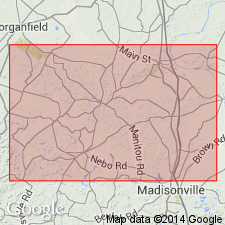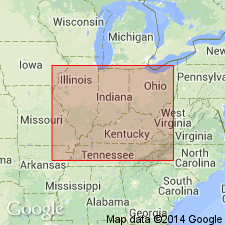
- Usage in publication:
-
- Dixon sandstone
- Modifications:
-
- Original reference
- Dominant lithology:
-
- Sandstone
- AAPG geologic province:
-
- Illinois basin
Summary:
Pg. 26. Dixon sandstone. Fine-grained variable sandstone 10 to 60 feet thick forming basal member of Dixon [Henshaw] formation in Webster County, western Kentucky. [Age is Pennsylvanian.]
Source: US geologic names lexicon (USGS Bull. 896, p. 614).

- Usage in publication:
-
- Dixon sandstone†
- Modifications:
-
- Abandoned
- AAPG geologic province:
-
- Illinois basin
Summary:
†Dixon sandstone in Henshaw formation abandoned. Preoccupied in Silurian of Tennessee [Dixon clay of Foerste, 1903].
Named from Dixon, Webster Co., western KY, where it is well developed.
Source: US geologic names lexicon (USGS Bull. 896, p. 614).

- Usage in publication:
-
- Dixon sandstone member
- Modifications:
-
- Overview
- AAPG geologic province:
-
- Illinois basin
Summary:
Pg. 81. Dixon sandstone, basal member of Dixon formation. [Age is Pennsylvanian.]
Source: US geologic names lexicon (USGS Bull. 1200, p. 1126).
For more information, please contact Nancy Stamm, Geologic Names Committee Secretary.
Asterisk (*) indicates published by U.S. Geological Survey authors.
"No current usage" (†) implies that a name has been abandoned or has fallen into disuse. Former usage and, if known, replacement name given in parentheses ( ).
Slash (/) indicates name conflicts with nomenclatural guidelines (CSN, 1933; ACSN, 1961, 1970; NACSN, 1983, 2005, 2021). May be explained within brackets ([ ]).

